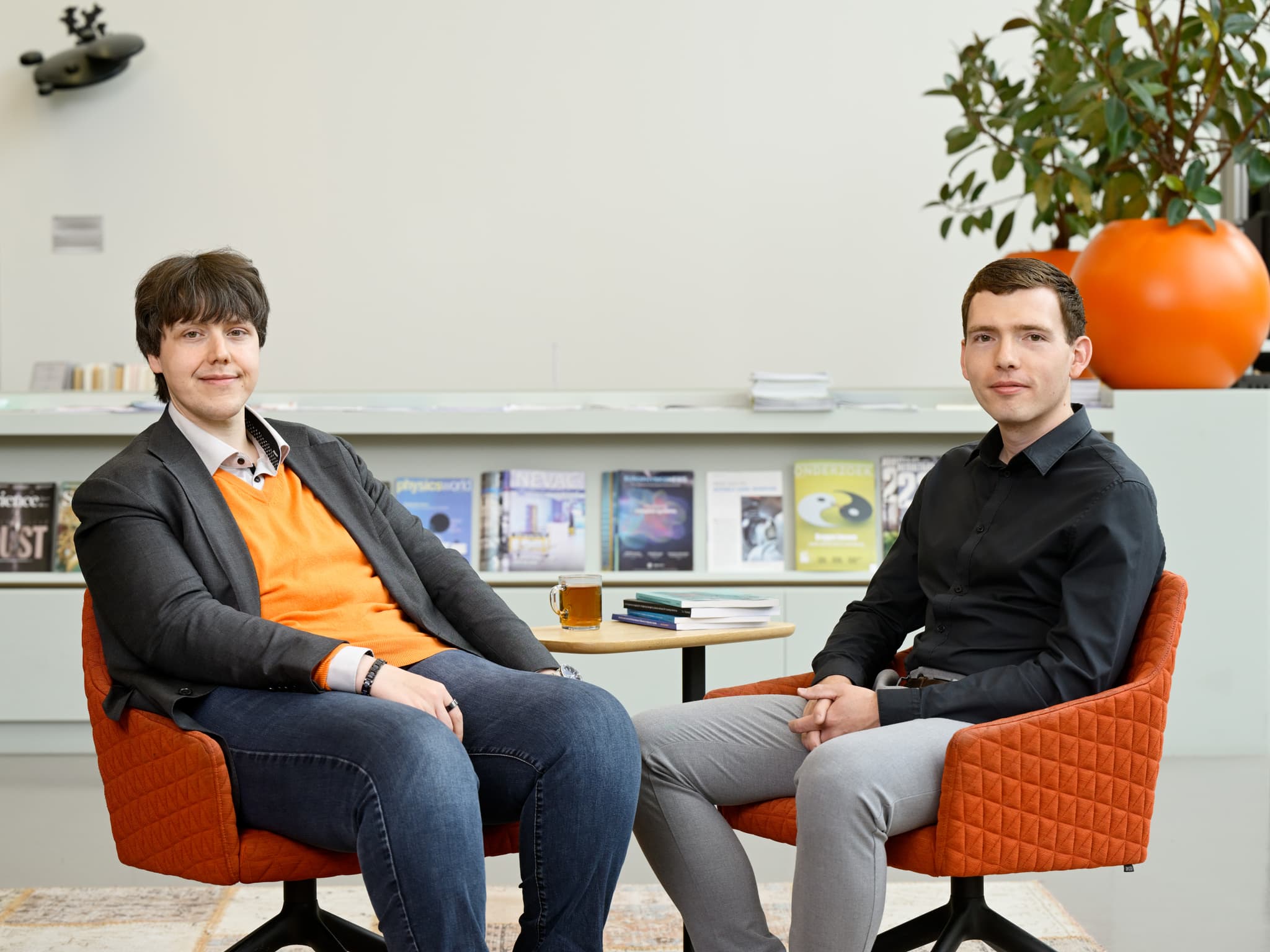‘Solution to major challenge in nuclear fusion energy closer’
Innovative ‘Super-X’ design shows advantages for heat management in the exhaust of nuclear fusion reactors.
Published on September 5, 2025

Kevin Verhaegh and Bob Kool, DIFFER © Bart van Overbeeke
Team IO+ selects and features the most important news stories on innovation and technology, carefully curated by our editors.
International experiments at the British fusion machine, MAST Upgrade, in Culham, led by Dutch researchers, demonstrate how the innovative ‘Super-X’ design offers significant advantages in managing the hot particles in the exhaust of fusion energy machines. Successfully controlling these hot particles is one of the biggest obstacles to realizing fusion energy. The results have been published in the leading journals Communication Physics and Nature Energy.
Temperatures exceeding 10,000 degrees Celsius and a ‘hailstorm’ of charged fusion particles: these are the extreme conditions that the exhaust wall (divertor) of future fusion power plants must be able to withstand. Dealing with this stream of exhaust particles is one of the biggest challenges in realizing clean, safe, and affordable commercial fusion power plants.
Beyond proof-of-concept
Initial proof-of-concept studies have already shown that the Super-X exhaust design can reduce the heat load by a factor of ten compared to conventional designs. The new experimental results take these initial observations beyond proof-of-concept by demonstrating the key benefits for fusion power plants: improved control over the energy exhaust while maintaining the complexity of the technology.
MAST Upgrade, the UK's national fusion experiment, was purpose-built by the United Kingdom Atomic Energy Authority (UKAEA) to develop solutions for the exhaust of fusion machines. The Super-X design, developed from a concept originating at the Institute for Fusion Studies at the University of Texas at Austin, has a longer exhaust. With longer ‘legs’ of plasma compared to conventional designs, it provides more space to cool the plasma before it hits the walls of the exhaust.
World first for alternative concept
The new results are a world first: at MAST Upgrade, researchers have demonstrated that the Super-X approach enables exhaust control without affecting the opposite exhaust or the core of the plasma where fusion energy is produced. The researchers demonstrate that, compared to conventional designs, it is considerably easier to control the desired, more favorable conditions in a Super-X configuration. These results give confidence in finding a solution for the exhaust of fusion reactors. They build on previous findings that the Super-X configuration at MAST Upgrade enables the integration of a hot plasma core with cold exhaust conditions.
The experiments further demonstrated that even a modest modification of the exhaust ‘legs’ compared to the conventional ‘short leg’ design already offers significant advantages in controlling the fusion heat. This is consistent with predictions from computer models, which provide a better understanding of the exhaust design. Future fusion projects can therefore benefit from significantly improved conditions in the exhaust and control over the hot exhaust gases, while maintaining a balanced complexity of the technology.
Dutch contribution
The results on the physical and technical aspects of the Super-X exhaust were published in the leading journals Communication Physics and Nature Energy. Dutch fusion researchers Kevin Verhaegh (formerly employed by the United Kingdom Atomic Energy Authority, currently at Eindhoven University of Technology, TU/e) and Bob Kool (Dutch energy research institute DIFFER and TU/e) led the work in a collaboration between the research teams of UKAEA and the European EUROfusion.
“These results bode well for various future projects, such as the STEP machine in the United Kingdom, the ARC machine in the US, and the European DEMO machine,” says Kevin Verhaegh, TU/e, Science and Technology of Nuclear Fusion (AP). “We were able to demonstrate that even a modest, strategic modification of the machine's exhaust can offer many of the advantages of more extreme designs. However, because extreme exhaust designs are difficult to implement in a fusion reactor, our results open new doors for improving the design of future fusion machines.”
According to Bob Kool, DIFFER and TU/e, Control System Technology (ME), these results demonstrate the many advantages that alternative exhaust designs can offer in dissipating heat and thereby maintaining acceptable exhaust conditions. “This is an important step in solving the exhaust problem and ultimately brings us closer to the realization of fusion energy.”
